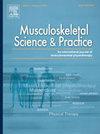Reporting and incorporation of social risks in low back pain and exercise studies: A scoping review
IF 2.2
3区 医学
Q1 REHABILITATION
引用次数: 0
Abstract
Background
Exercise is a common intervention for low back pain, but its effect sizes are small to modest. Social risk factors significantly influence health outcomes, yet their consideration in randomized controlled trials on exercise for low back pain is often neglected. Determining their relationship to outcomes may provide better insight into exercise effectiveness.
Objectives
To assess the reporting of social risk factors (SRFs) in randomized controlled trials (RCTs) of exercise interventions for low back pain (LBP) in adults and explore associations between SRFs and outcomes.
Design
Scoping Review.
Methods
The databases MEDLINE, CINAHL and Cochrane were searched for studies published between January 2014 to March 2025. RCTs were included if exercise was the primary intervention for LBP treatment and had a minimum follow-up of 12 weeks. A planned analysis of SRF and outcome associations was not conducted due to insufficient data.
Results
A total of 10,292 studies were identified and 157 studies included. Fewer than half (47.1 %) reported any SRFs at baseline. Socioeconomic position (42.7 %) was most frequently reported, followed by social relationships (17.8 %), race/ethnicity/cultural context (8.3 %), residential/community context (1.3 %), and gender (0.6 %). Four studies incorporated SRFs in their outcome analyses; one examined associations with outcomes and found no significant association.
Conclusion
SRFs are underreported in RCTs of exercise interventions for LBP and are rarely analyzed in relation to primary outcomes, limiting our understanding of their impact. Future trials should prioritize collecting and reporting SRFs at baseline and incorporating them in outcome analyses to assess their influence on outcomes.
下腰背痛和运动研究中社会风险的报告和纳入:范围综述
背景:运动是治疗腰痛的一种常见干预手段,但其效果不大。社会风险因素显著影响健康结果,然而,在腰痛运动的随机对照试验中,社会风险因素的考虑往往被忽视。确定它们与结果的关系可以更好地了解运动的有效性。目的评估成人腰痛(LBP)运动干预的随机对照试验(RCTs)中社会风险因素(SRFs)的报告情况,并探讨SRFs与结果之间的关系。DesignScoping审查。方法检索MEDLINE、CINAHL和Cochrane数据库,检索2014年1月至2025年3月发表的相关研究。如果运动是腰痛治疗的主要干预措施,并且随访时间至少为12周,则纳入rct。由于数据不足,没有进行SRF和结局关联的计划分析。结果共纳入10292项研究,纳入157项研究。不到一半(47.1%)的患者在基线时报告了任何srf。最常报告的是社会经济地位(42.7%),其次是社会关系(17.8%),种族/民族/文化背景(8.3%),居住/社区背景(1.3%)和性别(0.6%)。四项研究将srf纳入结果分析;一项研究了与结果的联系,发现没有显著的联系。结论在运动干预治疗腰痛的随机对照试验中,srf被低估,并且很少与主要结果进行分析,限制了我们对其影响的理解。今后的试验应优先在基线时收集和报告srf,并将其纳入结果分析,以评估其对结果的影响。
本文章由计算机程序翻译,如有差异,请以英文原文为准。
求助全文
约1分钟内获得全文
求助全文
来源期刊

Musculoskeletal Science and Practice
Health Professions-Physical Therapy, Sports Therapy and Rehabilitation
CiteScore
4.10
自引率
8.70%
发文量
152
审稿时长
48 days
期刊介绍:
Musculoskeletal Science & Practice, international journal of musculoskeletal physiotherapy, is a peer-reviewed international journal (previously Manual Therapy), publishing high quality original research, review and Masterclass articles that contribute to improving the clinical understanding of appropriate care processes for musculoskeletal disorders. The journal publishes articles that influence or add to the body of evidence on diagnostic and therapeutic processes, patient centered care, guidelines for musculoskeletal therapeutics and theoretical models that support developments in assessment, diagnosis, clinical reasoning and interventions.
 求助内容:
求助内容: 应助结果提醒方式:
应助结果提醒方式:


